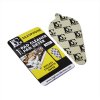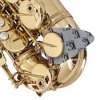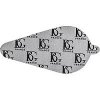Following on from a post in another thread...
I have a sticky G# key on a Bauhaus Walstein alto sax, (Phosphor bronze with improved action). the sax is only 1 year old and the pad looks clean and intact. It's started sticking recently and is getting progressively worse.
I cleaned the pad, on Friday, with Nathpa (cigarette lighter fuel) and a Q tip (not for the first time - I have probably cleaned it 4 times in total). I also used very fine emery paper on the tone hole - as explained in Stephen Howard's book - and it worked perfectly for 24 hours. The response was probably faster than it has ever been.
Today, it was completely stuck down and wouldn't open even after a few depressions of the touch-piece, and this usually gets it going. Instead, I had to physically lift the key open with my finger and it's been working OK since.
My question(s):
1. Even though the pad looks clean and unbroken, would there sometimes be a case for having it changed, rather than persisting with the cleanings?
2. Do you recommend placing something between the key and the tone hole, when the sax is not in use? I have heard of using a business card for this purpose. I also have a BG pad cleaning cloth (very small piece, shaped like a teardrop), which I have considered leaving between the pad and the hole.
I have a sticky G# key on a Bauhaus Walstein alto sax, (Phosphor bronze with improved action). the sax is only 1 year old and the pad looks clean and intact. It's started sticking recently and is getting progressively worse.
I cleaned the pad, on Friday, with Nathpa (cigarette lighter fuel) and a Q tip (not for the first time - I have probably cleaned it 4 times in total). I also used very fine emery paper on the tone hole - as explained in Stephen Howard's book - and it worked perfectly for 24 hours. The response was probably faster than it has ever been.
Today, it was completely stuck down and wouldn't open even after a few depressions of the touch-piece, and this usually gets it going. Instead, I had to physically lift the key open with my finger and it's been working OK since.
My question(s):
1. Even though the pad looks clean and unbroken, would there sometimes be a case for having it changed, rather than persisting with the cleanings?
2. Do you recommend placing something between the key and the tone hole, when the sax is not in use? I have heard of using a business card for this purpose. I also have a BG pad cleaning cloth (very small piece, shaped like a teardrop), which I have considered leaving between the pad and the hole.



